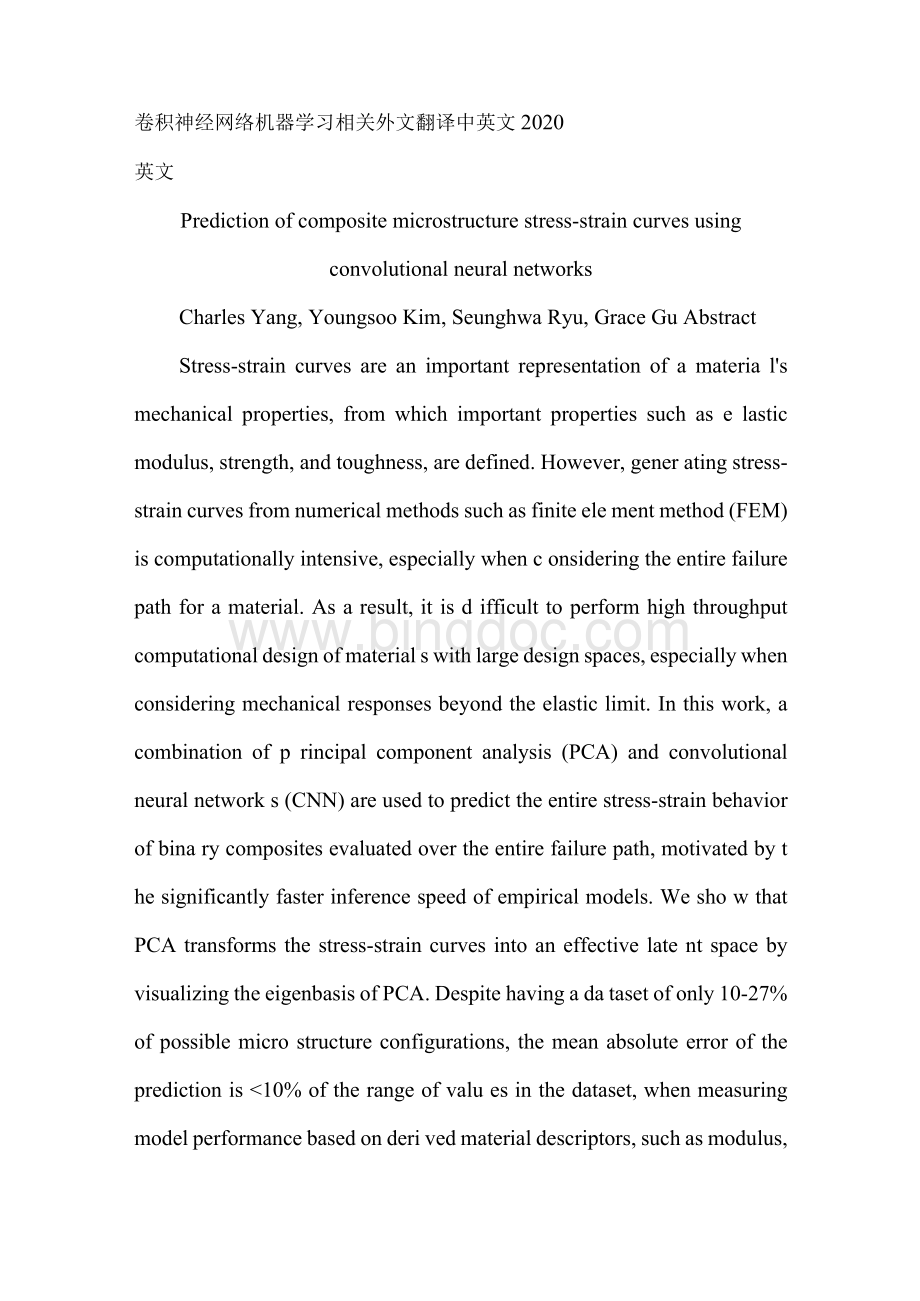卷积神经网络机器学习外文文献翻译中英文2020.docx
《卷积神经网络机器学习外文文献翻译中英文2020.docx》由会员分享,可在线阅读,更多相关《卷积神经网络机器学习外文文献翻译中英文2020.docx(16页珍藏版)》请在冰点文库上搜索。

卷积神经网络机器学习相关外文翻译中英文2020
英文
Predictionofcompositemicrostructurestress-straincurvesusing
convolutionalneuralnetworks
CharlesYang,YoungsooKim,SeunghwaRyu,GraceGuAbstract
Stress-straincurvesareanimportantrepresentationofamaterial'smechanicalproperties,fromwhichimportantpropertiessuchaselasticmodulus,strength,andtoughness,aredefined.However,generatingstress-straincurvesfromnumericalmethodssuchasfiniteelementmethod(FEM)iscomputationallyintensive,especiallywhenconsideringtheentirefailurepathforamaterial.Asaresult,itisdifficulttoperformhighthroughputcomputationaldesignofmaterialswithlargedesignspaces,especiallywhenconsideringmechanicalresponsesbeyondtheelasticlimit.Inthiswork,acombinationofprincipalcomponentanalysis(PCA)andconvolutionalneuralnetworks(CNN)areusedtopredicttheentirestress-strainbehaviorofbinarycompositesevaluatedovertheentirefailurepath,motivatedbythesignificantlyfasterinferencespeedofempiricalmodels.WeshowthatPCAtransformsthestress-straincurvesintoaneffectivelatentspacebyvisualizingtheeigenbasisofPCA.Despitehavingadatasetofonly10-27%ofpossiblemicrostructureconfigurations,themeanabsoluteerrorofthepredictionis<10%oftherangeofvaluesinthedataset,whenmeasuringmodelperformancebasedonderivedmaterialdescriptors,suchasmodulus,strength,andtoughness.Ourstudydemonstratesthepotentialtousemachinelearningtoacceleratematerialdesign,characterization,andoptimization.
Keywords:
Machinelearning,Convolutionalneuralnetworks,Mechanicalproperties,Microstructure,Computationalmechanics
Introduction
Understandingtherelationshipbetweenstructureandpropertyformaterialsisaseminalprobleminmaterialscience,withsignificantapplicationsfordesigningnext-generationmaterials.Aprimarymotivatingexampleisdesigningcompositemicrostructuresforload-bearingapplications,ascompositesofferadvantageouslyhighspecificstrengthandspecifictoughness.Recentadvancementsinadditivemanufacturinghavefacilitatedthefabricationofcomplexcompositestructures,andasaresult,avarietyofcomplexdesignshavebeenfabricatedandtestedvia3D-printingmethods.Whilemoreadvancedmanufacturingtechniquesareopeningupunprecedentedopportunitiesforadvancedmaterialsandnovelfunctionalities,identifyingmicrostructureswithdesirablepropertiesisadifficultoptimizationproblem.
Onemethodofidentifyingoptimalcompositedesignsisbyconstructinganalyticaltheories.Forconventionalparticulate/fiber-reinforcedcomposites,avarietyofhomogenizationtheorieshavebeendevelopedtopredictthemechanicalpropertiesofcompositesasafunctionofvolumefraction,aspectratio,andorientationdistributionofreinforcements.Becausemanynaturalcomposites,synthesizedviaseif-assemblyprocesses,haverelativelyperiodicandregularstructures,theirmechanicalpropertiescanbepredictediftheloadtransfermechanismofarepresentativeunitcellandtheroleoftheself-similarhierarchicalstructureareunderstood.However,theapplicabilityofanalyticaltheoriesislimitedinquantitativelypredictingcompositepropertiesbeyondtheelasticlimitinthepresenceofdefects,becausesuchtheoriesrelyontheconceptofrepresentativevolumeelement(RVE),astatisticalrepresentationofmaterialproperties,whereasthestrengthandfailureisdeterminedbytheweakestdefectintheentiresampledomain.Numericalmodelingbasedonfiniteelementmethods(FEM)cancomplementanalyticalmethodsforpredictinginelasticpropertiessuchasstrengthandtoughnessmodulus(referredtoastoughness,hereafter)whichcanonlybeobtainedfromfullstress-straincurves.
However,numericalschemescapableofmodelingtheinitiationandpropagationofthecurvilinearcracks,suchasthecrackphasefieldmodel,arecomputationallyexpensiveandtime-consumingbeeauseaveryfinemeshisrequiredtoaccommodatehighlyconcentratedstressfieldnearcracktipandtherapidvariationofdamageparameterneardiffusivecracksurface.Meanwhile,analyticalmodelsrequiresignificanthumaneffortanddomainexpertiseandfailtogeneralizetosimilardomainproblems.Inordertoidentifyhigh-performingcompositesinthemidstoflargedesignspaceswithinrealistictime-frames,weneedmodelsthatcanrapidlydescribethemechanicalpropertiesofcomplexsystemsandbegeneralizedeasilytoanalogoussystems.Machinelearningoffersthebenefitofextremelyfastinferencetimesandrequiresonlytrainingdatatolearnrelationshipsbetweeninputsandoutputse.g.,compositemicrostructuresandtheirmechanicalproperties.Machinelearninghasalreadybeenappliedtospeeduptheoptimizationofseveraldifferentphysicalsystems,includinggraphenekirigamicuts,fine-tuningspinqubitparameters,andprobemicroscopytuning.Suchmodelsdonotrequiresignificanthumaninterventionorknowledge,learnrelationshipsefficientlyrelativetotheinputdesignspace,andcanbegeneralizedtodifferentsystems.
Inthispaper,weutilizeacombinationofprincipalcomponentanalysis(PCA)andconvolutionalneuralnetworks(CNN)topredicttheentirestress-straincurveofcompositefailuresbeyondtheelasticlimit.Stress-straincurvesarechosenasthemodel'stargetbecausetheyaredifficulttopredictgiventheirhighdimensionality.Inaddition,stress-straincurvesareusedtoderiveimportantmaterialdescriptorssuchasmodulus,strength,andtoughness.Inthissense,predietingstress-straincurvesisamoregeneraldescriptionofcompositespropertiesthananycombinationofscalermaterialdescriptors.Adatasetof100,000differentcompositemicrostructuresandtheircorrespondingstress-straincurvesareusedtotrainandevaluatemodelperformance.Duetothehighdimensionalityofthestress-straindataset,severaldimensionalityreductionmethodsareused,includingPCA,featuringablendofdomainunderstandingandtraditionalmachinelearning,tosimplifytheproblemwithoutlossofgeneralityforthemodel.
Wewillfirstdescribeourmodelingmethodologyandtheparametersofourfinite-elementmethod(FEM)usedtogeneratedata.VisualizationsofthelearnedPCAlatentspacearethenpresented,alongwithmodelperformanceresults.
CNNimplementationandtraining
Aconvolutionalneuralnetworkwastrainedtopredictthislowerdimensionalrepresentationofthestressvector.TheinputtotheCNNwasabinarymatrixrepresentingthecompositedesign,with0'scorrespondingtosoftblocksandl'scorrespondingtostiffblocks.PCAwasimplementedwiththeopen-sourcePythonpackagescikit-learn,usingthedefaulthyperparameters.CNNwasimplementedusingKeraswithaTensorFlowbackend.Thebatchsizeforallexperimentswassetto16andthenumberofepochsto30;theAdamoptimizerwasusedtoupdatetheCNNweightsduringbackpropagation.
Atrain/testsplitratioof95:
5isused—wejustifyusingasmallerratiothanthestandard80:
20becauseofarelativelylargedataset.Witharatioof95:
5andadatasetwith100,000instances,thetestsetsizestillhasenoughdatapoints,roughlyseveralthousands,foritsresultstogeneralize.EachcolumnofthetargetPCA-representationwasnormalizedtohaveameanof0andastandarddeviationof1topreventinstabletraining.
Finiteelementmethoddatageneration
FEMwasusedtogeneratetrainingdatafortheCNNmodel.Althoughinitiallyobtainedtrainingdataiscompute-intensive,ittakesmuchlesstimetotraintheCNNmodelandevenlesstimetomakehigh-throughputinferencesoverthousandsofnew,randomlygeneratedcomposites.Thecrackphasefieldsolverwasbasedonthehybridformulationforthequasi-staticfractureofelasticsolidsandimplementedinthecommercialFEMsoftwareABAQUSwithauser-elementsubroutine(UEL).
VisualizingPCA
InordertobetterunderstandtherolePCAplaysineffectivelycapturingtheinformationcontainedinstress-straincurves,theprincipalcomponentrepresentationofstress-straincurvesisplottedin3dimensions.Specifically,wetakethefirstthreeprincipalcomponents,whichhaveacumulativeexplainedvariance-85%,andplotstress-straincurvesinthatbasisandprovideseveraldifferentanglesfromwhichtoviewthe3Dplot.Eachpointrepresentsastress-straincurveinthePCAlatentspaceandiscoloredbasedontheassociatedmodulusvalue,itseemsthatthePCAisabletospreadoutthecurvesinthelatentspacebasedonmodulusvalues,whichsuggeststhatthisisausefullatentspaceforCNNtomakepredictionsin.
CNNmodeldesignandperformance
OurCNNwasafullyconvolutionalneuralnetworki.e.theonlydenselayerwastheoutputlayer.Allconvolutionlayersused16filterswithastrideof1,withaLeakyReLUactivationfollowedbyBatchNormalization.Thefirst3Convblocksdidnothave2DMaxPooling,followedby9convblockswhichdidhavea2DMaxPoolinglayer,placedaftertheBatchNormalizationlayer.AGlobalAveragePoolingwasusedtoreducethedimensionalityoftheoutputtensorfromthesequentialconvolutionblocksandthefinaloutputlayerwasaDenselayerwith15nodes,whereeachnodecorrespondedtoaprincipalcomponent.Intotal,ourmodelhad26,319trainable
weights.
Ourarchitecturewasmotivatedbytherecentdevelopmentandconvergenceontofully-convolutionalarchitecturesfortraditionalcomputervisionapplications,whereconvolutionsareempiricallyobservedtobemoreefficientandstableforlearningasopposedtodenselayers.Inaddition,inourpreviouswork,wehadshownthatCNN'swereacapablearchitecturefor